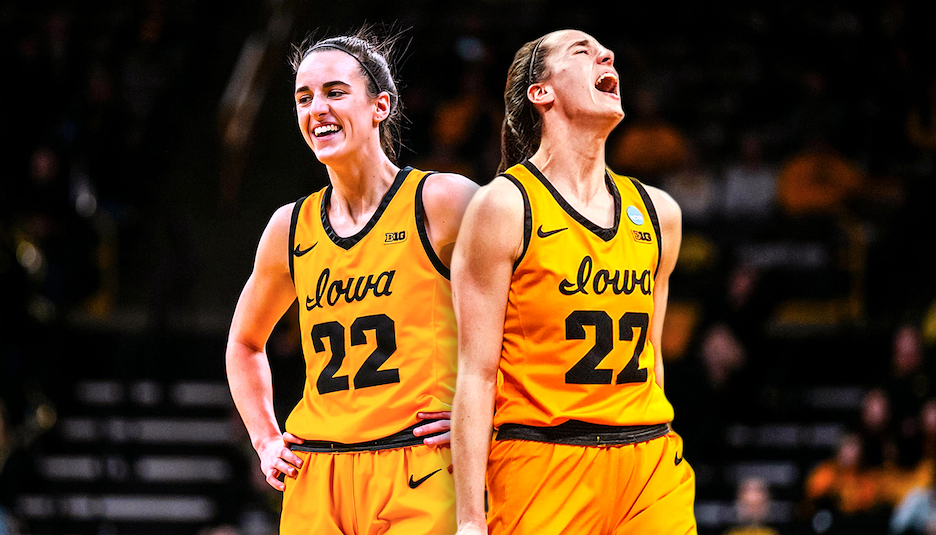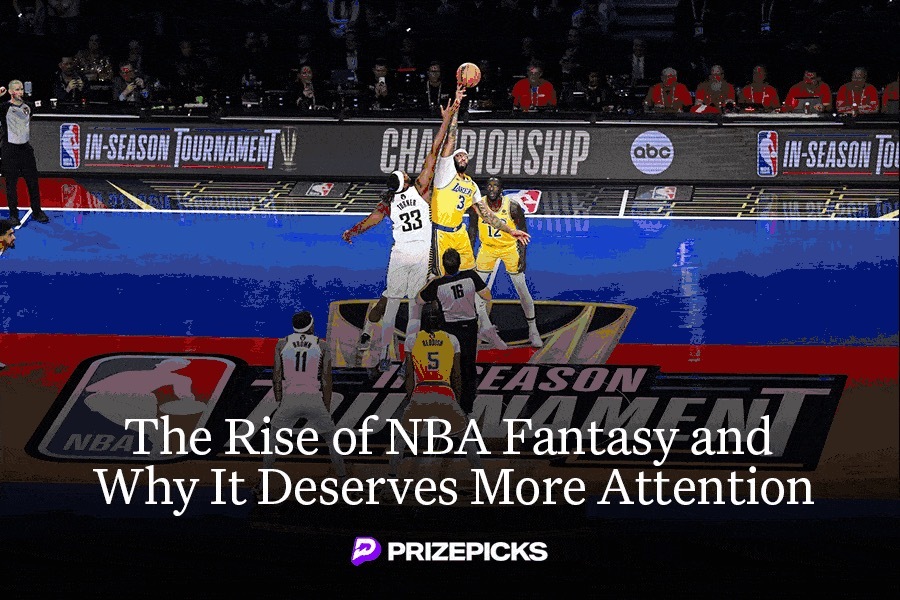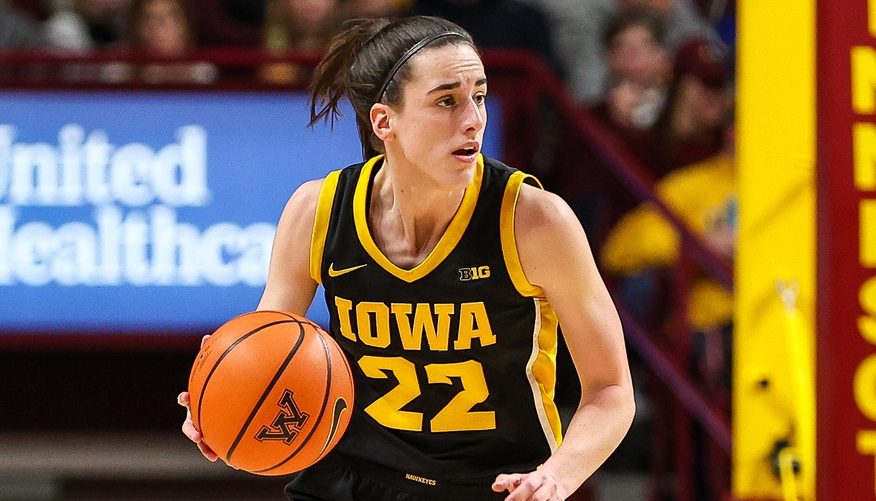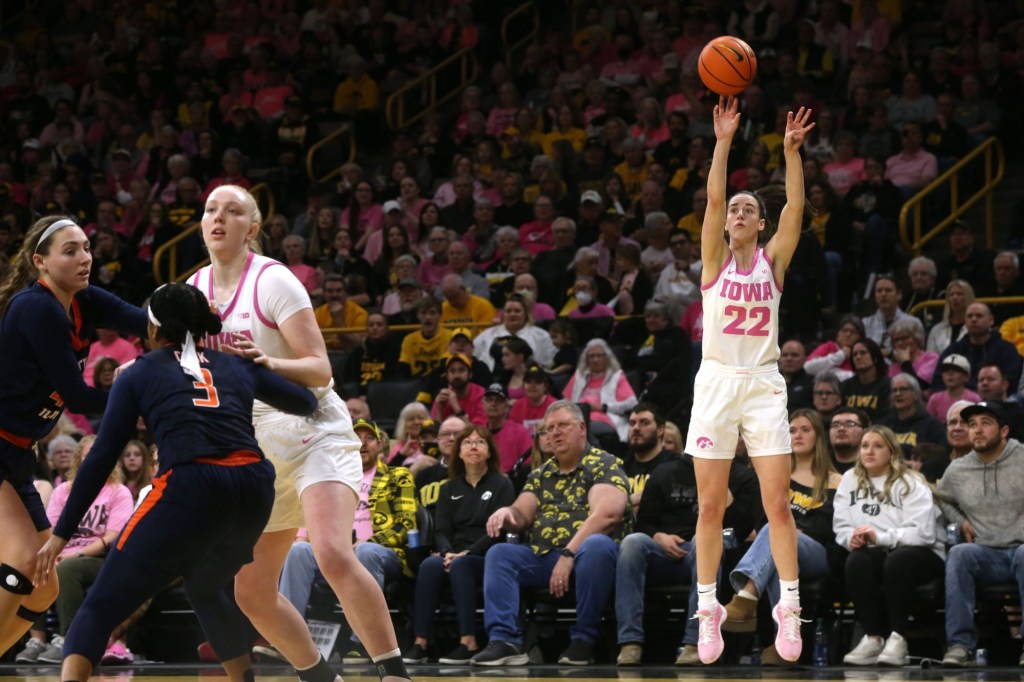Anne Cody, 67, and her husband, Mark, 70, were standing near the front of the long line waiting to get into the Iowa-Indiana women’s basketball game at Assembly Hall. They had traveled from Williamston, Mich., and were rotating spots with family members for 7.5 hours before the gates were set to open at 6 p.m. As expected, they were there to see Caitlin Clark.
“We would’ve paid any amount of money to come see her play in person,” Anne said.
The Codys are some of many Iowa fans traveling across the country and powering the Caitlin Clark economy. But they’re not the only ones—“Clarkonomics” is a misunderstood phenomenon.
It’s typically portrayed as thousands of young female fans driving or flying from all over the country with yellow-and-black signs, lines stretching around campuses to get into sold-out arenas, and broadcasts regularly drawing record viewership.
But the Caitlin Clark economy is powered by much more than adoring young female fans. In the first place, many of her fans are neither young nor female. And the haters drive the economy just as much as the Hawkeyes fans. They find her brazen style of play disrespectful, her confidence controversial, and her success infuriating. Hoosiers fans brought signs poking fun at her. They made memes on their phones to hold up for the cameras during TV timeouts. They cheered every time she missed a shot and roared when the final buzzer sounded to seal a surprise victory. (Many of these fans have been invested in the sport before Clark stole the spotlight.)
Whether you love her or hate her, Clark is bringing the women’s hoops economy to the next level.
Familiar Faces
Ten-year-old Noe Snyder comes from a family of UCLA fans—she lives in Los Angeles, and her mom is a Bruins alum. Snyder has no connections to Iowa, but that didn’t stop her from adopting the team as her own.
“She saw Caitlin Clark, and she was like, ‘That’s who I’m rooting for,’” Snyder’s dad, Blane, 37, said with a laugh.
The two traveled more than 2,000 miles to Bloomington for Noe’s first opportunity to see Clark play in person—a fact Noe painted on a giant sign she held up throughout the game (one of two that she brought to Assembly Hall).

Weeknight stays in Bloomington were busier than usual. The Courtyard by Marriott in Bloomington, one of the more popular hotels, was completely sold out, according to Expedia. There was limited availability in other places, with rates for the on-campus hotel, The Graduate, $97 higher per night than normal. None of that includes families like the Snyders, who stayed in Indianapolis and took an hour-long drive into Bloomington on game day.
The father-daughter duo bought specific tickets in advance, but Blane soon learned that general admission seating could get them closer to the court. So Noe woke up at 7:30 a.m. (4:30 Pacific time), and the two arrived at the Assembly Hall line at 9:30 a.m.—more than eight hours before the gates opened. Instead of halfway up the main section, over in a corner of the arena, the Snyders ended up in the first row at half court. Noe was so close that when Clark came out for warmups, Noe interrupted the interview to excitedly point her out.
More than 17,000 other fans joined them—a true sellout—many of whom also waited for hours, bringing blankets, snacks, and folding chairs. Front Office Sports spoke with other fans who got to Assembly Hall at 12 p.m. and at 2:30 p.m. Those who arrived at 5 p.m., one hour before the gates opened and three hours before tip-off, were relegated to the end of the lines.
For the Snyders, the trip cost between $1,500 and $2,000, Blane estimates.
Appealing to the Masses
Not all Clark fans look like Noe and Blane Snyder.
The first Iowa fans FOS spotted in Bloomington on game day were two men eating at the Uptown Cafe, a famous local brunch spot, one of whom was decked out from head to toe in Iowa gear: a beanie, a jersey, and bright yellow sneakers. After the game, a family with two young boys were the last, coming out of the hotel elevator.
Former WWE star Mick Foley showed up two hours before game time sporting a Caitlin Clark shirt under a red Hawaiian-style button-down. The 58-year-old retired wrestler told reporters he was born in Bloomington—but recently, he’s become a Clark fan. Victor Oladipo, a former Hoosier and two-time NBA All-Star, also made an appearance. His presence was met with a roar from the hometown crowd when announced on the Assembly Hall jumbotron in the second quarter.

Larry and Debbie McConnell, both 68, drove six-plus hours from Pittsburgh to see Clark. They had purchased tickets for their daughter and her family, but they ended up taking the trip alone since other family members got sick. Larry estimates the couple spent about $350 for a two-night stay in a hotel—and more for gas money, tickets, and other incidentals. When the McConnells spoke with FOS, they had already been standing in line for three hours.
The McConnells spent like diehard Iowa fans, but they have no connection to the team and don’t describe themselves as major college hoops fans. Why did they come? “I like watching Caitlin Clark on TV the past three years,” Larry says. “She’s such a competitor; that’s what I like about her.”
Some of the fans powering the Caitlin Clark economy, like the McConnells, don’t love college basketball. Others don’t even like her. Visit Bloomington’s leisure marketing manager, Jordan Smith, calls her “the most polarizing figure in the college game today.”
The electricity in Assembly Hall was due mostly to Indiana fans. The game was a “whiteout,” which made it clear that the majority of fans were there to support the Hoosiers. “Who is Caitlin Clark anyways? EW,” read one sign. Another warned fans to “watch out for ‘The Flopper,’” complete with an illustration of fish. The student section filled more than an hour before tip, leading the crowd with cheers and boos related to Clark’s performance.
Of Clark, one Indiana student told Iowa news station KCRG: “Never heard of her. … All I see is cream and crimson, baby.”
Iron Sharpens Iron
The traveling road show of Caitlin Clark only brought the best out of a place that’s no stranger to college basketball. After all, it’s not as if the sport was fanless before the Clark phenomenon began: For the past five years, viewership has been surging, and stars like Sabrina Ionescu have been captivating fans.
“We are used to seeing a lot of Hoosier fans on game day. We are used to seeing fans of the opposing team on game day,” says Smith.

It’s difficult to say how much the game brought to the local sports bar scene, for example, given that the bars are often busy on any given game day. (It doesn’t hurt that some, like The Upstairs Pub, also offer $3 drinks on Thursday nights to lure the college students.) Smith also noted that hotels are often close to or at capacity surrounding men’s and women’s games—despite the men’s team’s struggles in recent years. Assembly Hall itself is one of the most famous in the entire sport.
After all, they are the No. 14 team in the country. The arena is home to some of the most historic moments in the sport. A statue of the famous 1976 men’s team, which went 32–0, towers over the main entrance. Tributes to late coach Bobby Knight are peppered throughout the arena. Photos of famous women’s players hang in the media room.
After the Hoosiers upset the Hawkeyes, Indiana coach Teri Moren began her comments by countering the idea that Clark was the only reason for the energy. “We knew it—people have said ‘the Caitlin Clark effect,’” she told reporters. “That probably has somewhat to do with it. But I also think that our fan base has continued to come out and support us. … We’re really just grateful for that.”
There’s no denying Clark’s draw anywhere she goes—including next season when she enters the WNBA. But as Moren noted, it’s not just her biggest fans. The naysayers, the haters, and the longtime women’s college basketball fans are all part of what powers the Caitlin Clark economy. The people booing her are as good for college basketball as the fans cheering her on.






